Obstetric outcomes after conservative treatment for cervical intraepithelial lesions and early invasive disease
- PMID: 29095502
- PMCID: PMC6486192
- DOI: 10.1002/14651858.CD012847
Obstetric outcomes after conservative treatment for cervical intraepithelial lesions and early invasive disease
Abstract
Background: The mean age of women undergoing local treatment for pre-invasive cervical disease (cervical intra-epithelial neoplasia; CIN) or early cervical cancer (stage IA1) is around their 30s and similar to the age of women having their first child. Local cervical treatment has been correlated to adverse reproductive morbidity in a subsequent pregnancy, however, published studies and meta-analyses have reached contradictory conclusions.
Objectives: To assess the effect of local cervical treatment for CIN and early cervical cancer on obstetric outcomes (after 24 weeks of gestation) and to correlate these to the cone depth and comparison group used.
Search methods: We searched the following databases: Cochrane Central Register of Controlled Trials (CENTRAL; the Cochrane Library, 2017, Issue 5), MEDLINE (up to June week 4, 2017) and Embase (up to week 26, 2017). In an attempt to identify articles missed by the search or unpublished data, we contacted experts in the field and we handsearched the references of the retrieved articles and conference proceedings.
Selection criteria: We included all studies reporting on obstetric outcomes (more than 24 weeks of gestation) in women with or without a previous local cervical treatment for any grade of CIN or early cervical cancer (stage IA1). Treatment included both excisional and ablative methods. We excluded studies that had no untreated reference population, reported outcomes in women who had undergone treatment during pregnancy or had a high-risk treated or comparison group, or both DATA COLLECTION AND ANALYSIS: We classified studies according to the type of treatment and the obstetric endpoint. Studies were classified according to method and obstetric endpoint. Pooled risk ratios (RR) and 95% confidence intervals (CIs) were calculated using a random-effects model and inverse variance. Inter-study heterogeneity was assessed with I2 statistics. We assessed maternal outcomes that included preterm birth (PTB) (spontaneous and threatened), preterm premature rupture of the membranes (pPROM), chorioamnionitis, mode of delivery, length of labour, induction of delivery, oxytocin use, haemorrhage, analgesia, cervical cerclage and cervical stenosis. The neonatal outcomes included low birth weight (LBW), neonatal intensive care unit (NICU) admission, stillbirth, perinatal mortality and Apgar scores.
Main results: We included 69 studies (6,357,823 pregnancies: 65,098 pregnancies of treated and 6,292,725 pregnancies of untreated women). Many of the studies included only small numbers of women, were of heterogenous design and in their majority retrospective and therefore at high risk of bias. Many outcomes were assessed to be of low or very low quality (GRADE assessment) and therefore results should be interpreted with caution. Women who had treatment were at increased overall risk of preterm birth (PTB) (less than 37 weeks) (10.7% versus 5.4%, RR 1.75, 95% CI 1.57 to 1.96, 59 studies, 5,242,917 participants, very low quality), severe (less than 32 to 34 weeks) (3.5% versus 1.4%, RR 2.25, 95% CI 1.79 to 2.82), 24 studies, 3,793,874 participants, very low quality), and extreme prematurity (less than 28 to 30 weeks) (1.0% versus 0.3%, (RR 2.23, 95% CI 1.55 to 3.22, 8 studies, 3,910,629 participants, very low quality), as compared to women who had no treatment.The risk of overall prematurity was higher for excisional (excision versus no treatment: 11.2% versus 5.5%, RR 1.87, 95% CI 1.64 to 2.12, 53 studies, 4,599,416 participants) than ablative (ablation versus no treatment: 7.7% versus 4.6%, RR 1.35, 95% CI 1.20 to 1.52, 14 studies, 602,370 participants) treatments and the effect was higher for more radical excisional techniques (less than 37 weeks: cold knife conisation (CKC) (RR 2.70, 95% CI 2.14 to 3.40, 12 studies, 39,102 participants), laser conisation (LC) (RR 2.11, 95% CI 1.26 to 3.54, 9 studies, 1509 participants), large loop excision of the transformation zone (LLETZ) (RR 1.58, 95% CI 1.37 to 1.81, 25 studies, 1,445,104 participants). Repeat treatment multiplied the risk of overall prematurity (repeat versus no treatment: 13.2% versus 4.1%, RR 3.78, 95% CI 2.65 to 5.39, 11 studies, 1,317,284 participants, very low quality). The risk of overall prematurity increased with increasing cone depth (less than 10 mm to 12 mm versus no treatment: 7.1% versus 3.4%, RR 1.54, 95% CI 1.09 to 2.18, 8 studies, 550,929 participants, very low quality; more than 10 mm to 12 mm versus no treatment: 9.8% versus 3.4%, RR 1.93, 95% CI 1.62 to 2.31, 8 studies, 552,711 participants, low quality; more than 15 mm to 17 mm versus no treatment: 10.1 versus 3.4%, RR 2.77, 95% CI 1.95 to 3.93, 4 studies, 544,986 participants, very low quality; 20 mm or more versus no treatment: 10.2% versus 3.4%, RR 4.91, 95% CI 2.06 to 11.68, 3 studies, 543,750 participants, very low quality). The comparison group affected the magnitude of effect that was higher for external, followed by internal comparators and ultimately women with disease, but no treatment. Untreated women with disease and the pre-treatment pregnancies of the women who were treated subsequently had higher risk of overall prematurity than the general population (5.9% versus 5.6%, RR 1.24, 95% CI 1.14 to 1.34, 15 studies, 4,357,998 participants, very low quality).pPROM (6.1% versus 3.4%, RR 2.36, 95% CI 1.76 to 3.17, 21 studies, 477,011 participants, very low quality), low birth weight (7.9% versus 3.7%, RR 1.81, 95% CI 1.58 to 2.07, 30 studies, 1,348,206 participants, very low quality), NICU admission rate (12.6% versus 8.9%, RR 1.45, 95% CI 1.16 to 1.81, 8 studies, 2557 participants, low quality) and perinatal mortality (0.9% versus 0.7%, RR 1.51, 95% CI 1.13 to 2.03, 23 studies, 1,659,433 participants, low quality) were also increased after treatment.
Authors' conclusions: Women with CIN have a higher baseline risk for prematurity. Excisional and ablative treatment appears to further increases that risk. The frequency and severity of adverse sequelae increases with increasing cone depth and is higher for excision than it is for ablation. However, the results should be interpreted with caution as they were based on low or very low quality (GRADE assessment) observational studies, most of which were retrospective.
Conflict of interest statement
No known conflict of interest for the published work. Details are included in the individual conflict of interest forms completed by each author.
Figures
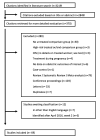





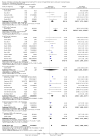














































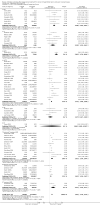
























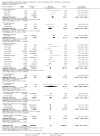


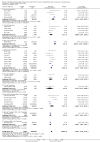


















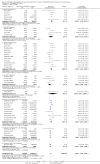




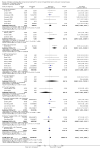







References
References to studies included in this review
Acharya 2005 {published data only}
-
- Acharya G, Kjeldberg I, Hansen SM, Sørheim N, Jacobsen BK, Maltau JM. Pregnancy outcome after loop electrosurgical excision procedure for the management of cervical intraepithelial neoplasia. Archives of Gynecology and Obstetrics 2005;272(2):109‐12. - PubMed
Albrechtsen 2008 {published data only}
Andersen 1999 {published data only}
-
- Andersen ES, Pedersen B, Boris J. Pregnancy outcome after combination laser conization: a case‐control study. Journal of Gynecologic Surgery 1999;15(1):7‐12.
Anderson 1984 {published data only}
-
- Anderson MC, Horwell DH, Broby Z. Outcome of pregnancy after laser vaporization conization. Journal of Gynecologic Surgery 1984;1(1):35‐9.
Andia 2011 {published data only}
-
- Andia D, Mozo de Rosales F, Villasante A, Rivero B, Diez J, Perez C. Pregnancy outcome in patients treated with cervical conization for cervical intraepithelial neoplasia. International Journal of Gynaecology and 0bstetrics 2011;112(3):225‐8. - PubMed
Anwar 2016 {published data only}
-
- Anwar A, Igbenehi C, Lindow SW, Noor N, Musa S, Saha, A. Pregnancy outcome after electrosurgical cervical cone biopsy using Fischer cone biopsy excisor. Journal of Maternal‐Fetal & Neonatal Medicine 2016;29(3):477‐81. - PubMed
Armarnik 2011 {published data only}
-
- Armarnik S, Sheiner E, Piura B, Meirovitz M, Zlotnik A, Levy A. Obstetric outcome following cervical conization. Archives of Gynecology and Obstetrics 2011;283(4):765‐9. - PubMed
Bekassy 1996 {published data only}
-
- Bekassy Z, Iosif CS. Laser "miniconisation' and the outcome of subsequent pregnancy. Archives of Gynecology and Obstetrics 1996;258(2):75‐9. - PubMed
Blomfield 1993 {published data only}
-
- Blomfield PI, Buxton J, Dunn J, Luesley DM. Pregnancy outcome after large loop excision of the cervical transformation zone. American Journal of Obstetrics and Gynecology 1993;169(3):620‐5. - PubMed
Braet 1994 {published data only}
-
- Braet PG, Peel JM, Fenton DW. A case controlled study of the outcome of pregnancy following loop diathermy excision of the transformation zone. Journal of Obstetrics and Gynaecology 1994;14(2):79‐82.
Bruinsma 2007 {published data only}
-
- Bruinsma F, Lumley J, Tan J, Quinn M. Precancerous changes in the cervix and risk of subsequent preterm birth. BJOG: an international journal of obstetrics and gynaecology 2007;114(1):70‐80. - PubMed
Buller 1982 {published data only}
-
- Buller RE, Jones HW 3rd. Pregnancy following cervical conization. American Journal of Obstetrics and Gynecology 1982;142(5):506‐12. - PubMed
Castanon 2012 {published and unpublished data}
Crane 2006 {published data only}
-
- Crane JM, Delaney T, Hutchens D. Transvaginal ultrasonography in the prediction of preterm birth after treatment for cervical intraepithelial neoplasia. Obstetrics and Gynecology 2006;107(1):37‐44. - PubMed
Cruickshank 1995 {published data only}
-
- Cruickshank ME, Flannelly G, Campbell DM, Kitchener HC. Fertility and pregnancy outcome following large loop excision of the cervical transformation zone. British Journal of Obstetrics and Gynaecology 1995;102(6):467‐70. - PubMed
Ehsanipoor 2014 {published data only}
-
- Ehsanipoor RM, Jolley JA, Goldshore MA, Szymanski LM, Haydon ML, Gaffaney CL, et al. The relationship between previous treatment for cervical dysplasia and preterm delivery in twin gestations. Journal of Maternal‐Fetal & Neonatal Medicine 2014;27(8):821‐4. - PubMed
El‐Bastawissi 1999 {published data only}
-
- El‐Bastawissi AY, Becker TM, Daling JR. Effect of cervical carcinoma in situ and its management on pregnancy outcome. Obstetrics and Gynecology 1999;93(2):207‐12. - PubMed
Fischer 2010 {published data only}
-
- Fischer RL, Sveinbjornsson G, Hansen C. Cervical sonography in pregnant women with a prior cone biopsy or loop electrosurgical excision procedure. Ultrasound in Obstetrics & Gynecology 2010;36(5):613‐7. - PubMed
Forsmo 1996 {published data only}
-
- Forsmo S, Hansen MH, Jacobsen BK, Oian P. Pregnancy outcome after laser surgery for cervical intraepithelial neoplasia. Acta Obstetricia et Gynecologica Scandinavica 1996;75(2):139‐43. - PubMed
Frega 2013 {published data only}
-
- Frega A, Sesti F, Sanctis L, Pacchiarotti A, Votano S, Biamonti A, et al. Pregnancy outcome after loop electrosurgical excision procedure for cervical intraepithelial neoplasia. International Journal of Gynaecology and Obstetrics 2013;122(2):145‐9. - PubMed
Frey 2013 {published data only}
Gunasekera 1992 {published data only}
-
- Gunasekera PC, Lewis BV, Phipps JH. Obstetric outcome after cervical surgery for intra‐epithelial neoplasia. Journal of Obstetrics and Gynaecology 1992;12(5):291‐3.
Guo 2013 {published data only}
-
- Guo HJ, Guo RX, Liu Y. Effects of loop electrosurgical excision procedure or cold knife conization on pregnancy outcomes. European Journal of Gynaecological Oncology 2013;34(1):79‐82. - PubMed
Haffenden 1993 {published data only}
-
- Haffenden DK, Bigrigg A, Codling BW, Read MD. Pregnancy following large loop excision of the transformation zone. British Journal of Obstetrics and Gynaecology 1993;100(11):1059‐60. - PubMed
Hagen 1993 {published data only}
-
- Hagen B, Skjeldestad FE. The outcome of pregnancy after CO2 laser conisation of the cervix. British Journal of Obstetrics and Gynaecology 1993;100(8):717‐20. - PubMed
Heinonen 2013 {published data only}
-
- Heinonen A, Gissler M, Riska A, Paavonen J, Tapper AM, Jakobsson M. Loop electrosurgical excision procedure and the risk for preterm delivery. Obstetrics and Gynecology 2013;121(5):1063‐8. - PubMed
Hemmingsson 1982 {published data only}
-
- Hemmingsson E. Outcome of third trimester pregnancies after cryotherapy of the uterine cervix. British Journal of Obstetrics and Gynaecology 1982;89(8):675‐7. - PubMed
Himes 2007 {published data only}
-
- Himes KP, Simhan HN. Time from cervical conization to pregnancy and preterm birth. Obstetrics and Gynecology 2007;109(2 Pt 1):314‐9. - PubMed
Jakobsson 2007 {published data only}
-
- Jakobsson M, Gissler M, Sainio S, Paavonen J, Tapper AM. Preterm delivery after surgical treatment for cervical intraepithelial neoplasia. Obstetrics and Gynecology 2007;109(2 Pt 1):309‐13. - PubMed
Jakobsson 2009 {published data only}
-
- Jakobsson M, Gissler M, Paavonen J, Tapper AM. Loop electrosurgical excision procedure and the risk for preterm birth. Obstetrics and Gynecology 2009;114(3):504‐10. - PubMed
Jones 1979 {published data only}
-
- Jones JM, Sweetnam P, Hibbard BM. The outcome of pregnancy after cone biopsy of the cervix: a case‐control study. British Journal of Obstetrics and Gynaecology 1979;86(12):913‐6. - PubMed
Kirn 2015 {published data only}
-
- Kirn V, Geiger P, Riedel C, Bergauer F, Friese K, Kainer F, Knabl J. Cervical conisation and the risk of preterm delivery: a retrospective matched pair analysis of a German cohort. Archives of Gynecology and Obstetrics 2015;291(3):599‐603. - PubMed
Kitson 2014 {published data only}
-
- Kitson SJ, Greig E, Michael E, Smith M. Predictive value of volume of cervical tissue removed during LLETZ on subsequent preterm delivery: a cohort study. European Journal of Obstetrics and Gynecology and Reproductive Biology 2014;180:51‐5. - PubMed
Klaritsch 2006 {published data only}
-
- Klaritsch P, Reich O, Giuliani A, Tamussino K, Haas J, Winter R. Delivery outcome after cold‐knife conization of the uterine cervix. Obstetrics and Gynecology 2006;103(2):604‐7. - PubMed
Kristensen 1985 {published data only}
-
- Kristensen GB. The outcome of pregnancy and preterm delivery after conization of the cervix. Archives of Gynecology 1985;236(3):127‐30. - PubMed
Kristensen 1993 {published data only}
-
- Kristensen J, Langhoff‐Ross J, Kristensen FB. Increased risk of preterm birth in women with cervical conization. Obstetrics and Gynecology 1993;81(6):1005‐8. - PubMed
Kuoppala 1986 {published data only}
-
- Kuoppala T, Saarikoski S. Pregnancy and delivery after cone biopsy of the cervix. Archives of Gynecology 1986;237(3):149‐54. - PubMed
Larsson 1982 {published data only}
-
- Larsson G, Grundsell H, Gullberg B, Svennerud S. Outcome of pregnancy after conization. Acta Obstetricia et Gynecologica Scandinavica 1982;61(5):461‐6. - PubMed
Lima 2011 {published data only}
-
- Lima AF, Francisco C, Julio C, Paula T, Vitorino A, Borrego J. Obstetric outcomes after treatment for cervical intraepithelial neoplasia: six years of experience. Journal of Lower Genital Tract Disease 2011;15(14):276‐9. - PubMed
Ludviksson 1982 {published data only}
-
- Ludviksson K, Sandstrom B. Outcome of pregnancy after cone biopsy‐‐a case‐control study. European Journal of Obstetrics and Gynecology and Reproductive Biology 1982;14(3):135‐42. - PubMed
Martyn 2015 {published data only}
-
- Martyn FM, McAuliffe FM, Beggan C, Downey P, Flannelly G, Wingfield MB. Excisional treatments of the cervix and effect on subsequent fertility: a retrospective cohort study. European Journal of Obstetrics and Gynecology and Reproductive Biology 2015;185:114‐20. - PubMed
Miller 2015 {published data only}
-
- Miller ES, Sakowicz A, Grobman, WA. The association between cervical dysplasia, a short cervix, and preterm birth. American Journal of Obstetrics and Gynecology 2015;213:543 e1‐4. - PubMed
Moinian 1982 {published data only}
-
- Moinian M, Andersch B. Does cervix conization increase the risk of complications in subsequent pregnancies?. Acta Obstetricia et Gynecologica Scandinavica 1982;61(2):101‐3. - PubMed
Noehr 2009a {published data only}
-
- Noehr B, Jensen A, Frederiksen K, Tabor A, Kjaer SK. Depth of cervical cone removed by loop electrosurgical excision procedure and subsequent risk of spontaneous preterm delivery. Obstetrics and Gynecology 2009;114(6):1232‐8. - PubMed
-
- Noehr B, Jensen A, Frederiksen K, Tabor A, Kjaer SK. Loop electrosurgical excision of the cervix and subsequent risk for spontaneous preterm delivery: a population‐based study of singleton deliveries during a 9‐year period. American Journal of Obstetrics and Gynecology 2009;201(1):33.e1‐6. - PubMed
-
- Nohr B, Tabor A, Frederiksen K, Kjaer SK. Loop electrosurgical excision of the cervix and the subsequent risk of preterm delivery. Acta Obstetricia et Gynecologica Scandinavica 2007;86(5):596‐603. - PubMed
Noehr 2009b {published data only}
-
- Noehr B, Jensen A, Frederiksen K, Tabor A, Kjaer SK. Loop electrosurgical excision of the cervix and risk for spontaneous preterm delivery in twin pregnancies. Obstetrics and Gynecology 2009;114(3):511‐5. - PubMed
Ortoft 2010 {published data only}
-
- Ortoft G, Henriksen T, Hansen E, Petersen L. After conisation of the cervix, the perinatal mortality as a result of preterm delivery increases in subsequent pregnancy. BJOG: an international journal of obstetrics and gynaecology 2010;117(3):258‐67. - PubMed
Paraskevaidis 2002 {published data only}
-
- Paraskevaidis E, Koliopoulos G, Lolis E, Papanikou E, Malamou‐Mitsi V, Agnantis NJ. Delivery outcomes following loop electrosurgical excision procedure for micro‐invasive (FIGO stage IA1) cervical cancer. Gynecologic Oncology 2002;86(1):10‐3. - PubMed
Parikh 2008 {published data only}
-
- Parikh R, Horne H, Feinstein SJ, Anasti JN. Cervical length screening in patients who have undergone loop electrosurgical excision procedure. Journal of Reporoductive Medicine 2008;53(12):909‐13. - PubMed
Poon 2012 {published data only}
-
- Poon LC, Savvas M, Zamblera D, Skyfta E, Nicolaides KH. Large loop excision of transformation zone and cervical length in the prediction of spontaneous preterm delivery. BGOJ: an international journal of obstetrics and gynaecology 2012;119(6):692‐8. - PubMed
Raio 1997 {published data only}
-
- Raio L, Ghezzi F, Naro E, Gomez R, Luscher KP. Duration of pregnancy after carbon dioxide laser conization of the cervix: influence of cone height. Obstetrics and Gynecology 1997;90(6):978‐82. - PubMed
Reilly 2012 {published data only}
-
- Reilly R, Paranjothy S, Beer H, Brooks CJ, Fielder HM, Lyons RA. Birth outcomes following treatment for precancerous changes to the cervix: a population‐based record linkage study. BJOG: an international journal of obstetrics and gynaecology 2012;119(2):236‐44. - PubMed
Sadler 2004 {published data only}
-
- Sadler L, Saftlas A, Wang W, Exeter M, Whittaker J, McCowan L. Treatment for cervical intraepithelial neoplasia and risk of preterm delivery. JAMA 2004;291(17):2100‐6. - PubMed
Sagot 1995 {published data only}
-
- Sagot P, Caroit Y, Winer N, Lopes P, Boog G. Obstetrical prognosis for carbon dioxide laser conisation of the uterine cervix. European Journal of Obstetrics and Gynecology and Reproductive Biology 1995;58(1):53‐8. - PubMed
Samson 2005 {published data only}
-
- Samson SL, Bentley JR, Fahey TJ, McKay DJ, Gill GH. The effect of loop electrosurgical excision procedure on future pregnancy outcome. Obstetrics and Gynecology 2005;105(2):325‐32. - PubMed
Saunders 1986 {published data only}
-
- Saunders N, Fenton DW, Soutter WP, Brown VA, Sharp F, Abernethy F. A case controlled study of the outcome of pregnancy following laser vaporization cone of the cervix. In: Sharp F, Jordan JA editor(s). Gynaecological Laser surgery: Proceedings of the Fifteenth Study Group of the Royal College of Obstetricians and Gynaecologists. Reproductive and Perinatal Medicine (VI). Ithaca, New York: Perinatology Press, 1986:121‐5.
Shanbhag 2009 {published data only}
-
- Shanbhag S, Clark H, Timmaraju V, Bhattacharya S, Cruickshank M. Pregnancy outcome after treatment for cervical intraepithelial neoplasia. Obstetrics and Gynecology 2009;114(4):727‐35. - PubMed
Simoens 2012 {published data only}
-
- Simoens C, Goffin F, Simon P, Barlow P, Antoine J, Foidart JM, et al. Adverse obstetrical outcomes after treatment of precancerous cervical lesions: a Belgian multicentre study. BJOG: an international journal of obstetrics and gynaecology 2012;119(10):1247‐55. - PubMed
Sjoborg 2007 {published data only}
-
- Sjoborg KD, Vistad I, Myhr SS, Svenningsen R, Herzog C, Kloster‐Jensen A, et al. Pregnancy outcome after cervical cone excision: a case‐control study. Acta Obstetricia et Gynecologica Scandinavica 2007;86(4):423‐8. - PubMed
Sozen 2014 {published data only}
-
- Sozen H, Namazov A, Cakir S, Akdemir Y, Vatansever D, Karateke A. Pregnancy outcomes after cold knife conization related to excised cone dimensions. A retrospective cohort study. Journal of Reporoductive Medicine 2014;59(1‐2):81‐6. - PubMed
Spitzer 1995 {published data only}
-
- Spitzer M, Herman J, Krumholz BA, Lesser M. The fertility of women after laser cervical conisation. Obstetrics and Gynecology 1995;86(4 Pt 1):504‐8. - PubMed
Stout 2015 {published data only}
Tan 2004 {published data only}
-
- Tan L, Pepra E, Haloob RK. The outcome of pregnancy after large loop excision of the transformation zone of the cervix. Journal of Obstetrics and Gynaecology 2004;24(1):25‐7. - PubMed
Turlington 1996 {published data only}
-
- Turlington WT, Wright BD, Powell JL. Impact of the loop electrosurgical excision procedure on future fertility. Journal of Reporoductive Medicine 1996;41(11):815‐8. - PubMed
van de Vijner 2010 {published data only}
-
- Vijver A, Poppe W, Verguts J, Arbyn M. Pregnancy outcome after cervical conisation: a retrospective cohort study in the Leuven University Hospital. BJOG: an international journal of obstetrics and gynaecology 2010;117(3):268‐73. - PubMed
Van Hentenryck 2012 {published data only}
-
- Hentenryck M, Noel JC, Simon P. Obstetric and neonatal outcome after surgical treatment of cervical dysplasia. European Journal of Obstetrics and Gynecology and Reproductive Biology 2012;162(1):16‐20. - PubMed
van Rooijen 1999 {published data only}
-
- Rooijen M, Persson E. Pregnancy outcome after laser vaporization of the cervix. Acta Obstetricia et Gynecologica Scandinavica 1999;78(4):346‐8. - PubMed
Weber 1979 {published data only}
-
- Weber T, Obel EB. Pregnancy complications following conization of the uterine cervix (II). Acta Obstetricia et Gynecologica Scandinavica 1979;58(4):347‐51. - PubMed
Werner 2010 {published data only}
-
- Werner CL, Lo JY, Heffernan T, Griffith WF, McIntire DD, Leveno KJ. Loop electrosurgical excision procedure and risk of preterm birth. Obstetrics and Gynecology 2010;115(3):605‐8. - PubMed
Wuntakal 2013 {published data only}
-
- Wuntakal R, Castanon A, Sasieni PD, Hollingworth A. Pregnancy outcomes after treatment for cervical intraepithelial neoplasia in a single NHS hospital. International Journal of Gynecological Cancer 2013;23(4):710‐5. - PubMed
References to studies excluded from this review
Al‐Halal 2013 {published data only}
-
- Al‐Halal H, Kezouh A, Abenhaim HA. Incidence and obstetrical outcomes of cervical intraepithelial neoplasia and cervical cancer in pregnancy: a population‐based study on 8.8 million births. Archives of Gynecology and Obstetrics 2013;287(2):245‐50. - PubMed
Althuisius 2001 {published data only}
-
- Althuisius SM, Schornagel IJ, Dekker GA, Geijn HP, Hummel P. Loop electrosurgical excision procedure of the cervix and time of delivery in subsequent pregnancy. International Journal of Gynaecology and Obstetrics 2001;72(1):31‐4. - PubMed
Berghella 2004 {published data only}
-
- Berghella V, Pereira L, Gariepy A, Simonazzi G. Prior cone biopsy: prediction of preterm birth by cervical ultrasound. American Journal of Obstetrics and Gynecology 2004;191(4):1393‐7. - PubMed
Berretta 2013 {published data only}
Bull‐Phelps 2007 {published data only}
-
- Bull‐Phelps SL, Garner EI, Walsh CS, Gehrig PA, Miller DS, Schorge JO. Fertility‐sparing surgery in 101 women with adenocarcinoma in situ of the cervix. Gynecologic Oncology 2007;107(2):316‐9. - PubMed
Chevreau 2017 {published data only}
Ciavattini 2014 {published data only}
-
- Ciavattini A, Stortoni P, Mancioli F, Puglia D, Tranquilli AL, Liverani CA. The impact of loop electrosurgical excision procedure (LEEP) for CIN 2,3 on spontaneous preterm delivery in twin pregnancies by assisted reproductive technique: preliminary data. Journal of Maternal‐Fetal & Neonatal Medicine 2014;27(11):1169‐71. - PubMed
Ciavattini 2015 {published data only}
-
- Ciavattini A, Clemente N, Delli Carpini G, Gentili C, Giuseppe J, Barbadoro P, et al. Loop electrosurgical excision procedure and risk of miscarriage. Fertility and Sterility 2015;103(4):1043‐8. - PubMed
Conner 2013 {published data only}
Ferenczy 1995 {published data only}
-
- Ferenczy A, Choukroun D, Falcone T, Franco E. The effect of cervical loop electrosurgical excision on subsequent pregnancy outcome: North American experience. American Journal of Obstetrics and Gynecology 1995;172(4 Pt 1):1246‐50. - PubMed
Gentry 2000 {published data only}
-
- Gentry DJ, Baggish MS, Brady K, Walsh PM, Hungler MS. The effects of loop excision of the transformation zone on cervical length: implications for pregnancy. American Journal of Obstetrics and Gynecology 2000;182(3):516‐20. - PubMed
Gordon 1991 {published data only}
-
- Gordon HK, Duncan ID. Effective destruction of cervical intraepithelial neoplasia (CIN) 3 at 100 degrees C using the Semm cold coagulator: 14 years experience. British Journal of Obstetrics and Gynaecology 1991;98(1):14‐20. - PubMed
Gronroos 1979 {published data only}
-
- Gronroos M, Liukko P, Kilkku P, Punnonen R. Pregnancy and delivery after conization of the cervix. Acta Obstetricia et Gynecologica Scandinavica 1979;58(5):477‐80. - PubMed
Kalliala 2012 {published data only}
-
- Kalliala I, Anttila A, Dyba T, Hakulinen T, Halttunen M, Nieminen P. Pregnancy incidence and outcome among patients with cervical intraepithelial neoplasia: a retrospective cohort study. BJOG: an international journal of obstetrics and gynaecology 2012;119(2):227‐35. - PubMed
Khalid 2012 {published data only}
-
- Khalid S, Dimitriou E, Conroy R, Paraskevaidis E, Kyrgiou M, Harrity C, et al. The thickness and volume of LLETZ specimens can predict the relative risk of pregnancy‐related morbidity. BJOG: an international journal of obstetrics and gynaecology 2012;119(6):685‐91. - PubMed
Kim 2016 {published data only}
-
- Kim M, Ishioka S, Endo T, Baba T, Saito T. Obstetrical prognosis of patients with cervical intraepithelial neoplasia (CIN) after "coin‐shaped" conization. Archives of Gynecology and Obstetrics 2016;293(3):651‐7. - PubMed
Kindinger 2016 {published data only}
Kullander 1971 {published data only}
-
- Kullander S, Sjoberg NO. Treatment of carcinoma in situ of the cervix uteri by conization. A five‐year follow‐up. Acta Obstetricia et Gynecologica Scandinavica 1971;50(2):153‐7. - PubMed
Leiman 1980 {published data only}
-
- Leiman G, Harrison NA, Rubin A. Pregnancy following conization of the cervix: complications related to cone size. American Journal of Obstetrics and Gynecology 1980;136(1):14‐8. - PubMed
Liu 2014 {published data only}
-
- Liu Y, Qiu HF, Tang Y, Chen J, Lv J. Pregnancy outcome after the treatment of loop electrosurgical excision procedure or cold‐knife conization for cervical intraepithelial neoplasia. Gynecological Obstetric Investigation 2014;77(4):240‐4. - PubMed
Liverani 2016 {published data only}
-
- Liverani CA, Giuseppe J, Clemente N, Delli Carpini G, Monti E, Fanetti F, et al. Length but not transverse diameter of the excision specimen for high‐grade cervical intraepithelial neoplasia (CIN 2‐3) is a predictor of pregnancy outcome. European Journal of Cancer Prevention 2016;25(5):416‐22. - PubMed
Macvicar 1968 {published data only}
-
- Macvicar J, Willocks J. The effect of diathermy conization of the cervix on subsequent fertility, pregnancy and delivery. Journal of Obstetrics and Gynaecology of the British Commonwealth 1968;75(3):355‐6. - PubMed
Mariya 2016 {published data only}
-
- Mariya T, Nishikawa A, Sogawa K, Suzuki R, Saito M, Kawamata A, ET AL. Virological and cytological clearance in laser vaporization and conization for cervical intra‐epithelial neoplasia grade 3. Journal of Obstetrics and Gynaecology Research 2016;42:1808‐13. - PubMed
Masamoto 2008 {published data only}
-
- Masamoto H, Nagai Y, Inamine M, Hirakawa M, Okubo E, Ishisoko A, et al. Outcome of pregnancy after laser conization: implications for infection as a causal link with preterm birth. Journal of Obstetrics and Gynaecology Research 2008;34(5):838‐42. - PubMed
Michelin 2009 {published data only}
-
- Michelin MA, Merino LM, Franco CA, Murta EF. Pregnancy outcome after treatment of cervical intraepithelial neoplasia by the loop electrosurgical excision procedure and cold knife conization. Clinical and Experimental Obstetrics & Gynecology 2009;36(1):17‐9. - PubMed
Mitsuhashi 2000 {published data only}
-
- Mitsuhashi A, Sekiya S. Loop electrosurgical excision procedure (LEEP) during first trimester of pregnancy. International Journal of Gynaecology and Obstetrics 2000;71(3):237‐9. - PubMed
Monaghan 1982 {published data only}
-
- Monaghan JM, Kirkup W, Davis JA, Edington PT. Treatment of cervical intraepithelial neoplasia by colposcopically directed cryosurgery and subsequent pregnancy experience. British Journal of Obstetrics and Gynaecology 1982;89(5):387‐92. - PubMed
Naleway 2015 {published data only}
Nam 2010 {published data only}
Novikova 1994 {published data only}
-
- Novikova EG, Antoshechkina MA. [Reproductive function after the organ‐preserving treatment of early cancerous pathology of the cervix uteri]. Akusherstvo i ginekologiia (Mosk) 1994;2:44‐7. - PubMed
Patrelli 2008 {published data only}
-
- Patrelli TS, Anfuso S, Vandi F, Valitutto S, Migliore M, Salvati MA, et al. Preterm delivery and premature rupture of membranes after conization in 80 women. Preliminary data. Minerva Ginecologica 2008;60(4):295‐8. - PubMed
Pils 2014 {published data only}
-
- Pils S, Eppel W, Seemann R, Natter C, Ott J. Sequential cervical length screening in pregnancies after loop excision of the transformation zone conisation: a retrospective analysis. BJOG : an international journal of obstetrics and gynaecology 2014;121(4):457‐62. - PubMed
Pinborg 2015 {published data only}
-
- Pinborg A, Ortoft G, Loft A, Rasmussen SC, Ingerslev HJ. Cervical conization doubles the risk of preterm and very preterm birth in assisted reproductive technology twin pregnancies. Human Reproduction 2015;30(1):197‐204. - PubMed
Radha Bai Prabhu 2010 {published data only}
-
- Radha Bai Prabhu T. Pregnancy outcome following large loop excision of the transformation zone (LLETZ). Journal of Obstetrics and Gynaecology of India 2010;60(2):149‐51.
Rafaeli‐Yehudai 2014 {published data only}
-
- Rafaeli‐Yehudai T, Kessous R, Aricha‐Tamir B, Sheiner E, Erez O, Meirovitz M, et al. The effect of cervical cerclage on pregnancy outcomes in women following conization. Journal of Maternal‐Fetal & Neonatal Medicine 2014;27(15):1594‐7. - PubMed
Ricciotti 1995 {published data only}
-
- Ricciotti HA, Burke L, Kobelin M, Slomovic B, Ludmir J. Ultrasound evaluation of cervical shortening after loop excision of the transformation zone (LETZ). International Journal of Gynaecology and Obstetrics 1995;50(2):175‐8. - PubMed
Rosen 1991 {published data only}
-
- Rosen A, Klein M, Vavra N, Gitsch G, Karasegh S, Schrock A, et al. [PAP IV in pregnancy‐‐a retrospective multicenter study]. Geburtshilfe Frauenheilkunde 1991;51(3):208‐10. - PubMed
Sangkarat 2014 {published data only}
-
- Sangkarat S, Ruengkhachorn I, Benjapibal M, Laiwejpithaya S, Wongthiraporn W, Rattanachaiyanont M. Long‐term outcomes of a loop electrosurgical excision procedure for cervical intraepithelial neoplasia in a high incidence country. Asian Pacific Journal of Cancer Prevention 2014;15(2):1035‐9. - PubMed
Seki 2010 {published data only}
-
- Seki N, Kodama J, Kusumoto T, Nakamura K, Hongo A, Hiramatsu Y. Complications and obstetric outcomes after laser conization during pregnancy. European Journal of Gynaecological Oncology 2010;31(4):399‐401. - PubMed
Shin 2010 {published data only}
Sljivancanin 2013 {published data only}
-
- Sljivancanin D, Kesic V, Tulic L, Dotlic J. [Assessment of the natural course and treatment of premalignant uterine cervical lesions in pregnancy]. Srpski Aarhiv za Celokupno Lekarstvo 2013;141(3‐4):192‐7. - PubMed
Smaldone 2010 {published data only}
-
- Smaldone GM, Krohn MA, McGee EA. Cervical cancer and risk for delivery of small‐for‐gestational age neonates. Journal of Womens Health (Larchmt) 2010;19(5):969‐74. - PubMed
Spracklen 2013 {published data only}
Wakita 1990 {published data only}
-
- Wakita K, Izumi T, Kuramoto H, Sasaki N, Shimada N. Pregnancy after laser therapy for the treatment of uterine cervical neoplasia. Journal of Clinical Laser Medicine & Surgery 1990;8(5):71‐6. - PubMed
Watson 2012 {published data only}
-
- Watson LF, Rayner JA, King J, Jolley D, Forster D. Intra‐cervical procedures and the risk of subsequent very preterm birth: a case‐control study. Acta Obstetricia et Gynecologica Scandinavica 2012;91(2):204‐10. - PubMed
Wongtiraporn 2014 {published data only}
-
- Wongtiraporn W, Laiwejpithaya S, Sangkarat S, Benjapibal M, Rattanachaiyanont M, Ruengkhachorn I, et al. Long term outcomes of laser conization for high grade cervical intraepithelial neoplasia in Thai women. Asian Pacific Journal of Cancer Prevention 2014;15(18):7757‐61. - PubMed
Zuo 2011 {published data only}
-
- Zuo Z, Goel S, Carter JE. Association of cervical cytology and HPV DNA status during pregnancy with placental abnormalities and preterm birth. American Journal of Clinical Pathology 2011;136(2):260‐5. - PubMed
References to studies awaiting assessment
Aleman 2016 {published data only}
-
- Aleman JM, Arien F, Tjalma WAA. The impact of conisation on pregnancy outcome. European Journal of Gynaecological Oncology 2016;37:786‐91. - PubMed
Bjorge 2016 {published data only}
-
- Bjorge T, Skare GB, Bjorge L, Trope A, Lonnberg S. Adverse pregnancy outcomes after treatment for cervical intraepithelial neoplasia. Obstetrics and Gynecology 2016;128(6):1265‐73. - PubMed
Brie 2016 {published data only}
-
- Brie C, Turck M, Cheret A, Morello R, Benoist G, Dreyfus M. [Case‐control study of obstetrical outcomes of conisation]. Journal de Gynécologie, Obstétrique et Biologie de la Reproduction [Journal of Gynecology Obstetrics and Human Reproduction] 2016;45(2):192‐7. - PubMed
He 2007 {published data only}
-
- He HJ, Pan LY, Huang HF, Lang JH. [Clinical analysis of the effect of cervical conization on fertility and pregnancy outcome]. Zhonghua Fu Chan Ke Za Zhi 2007;42(8):515‐7. - PubMed
Jancar 2016 {published data only}
-
- Jancar N, Mihevc Ponikvar B, Tomsic S. Cold‐knife conisation and large loop excision of transformation zone significantly increase the risk for spontaneous preterm birth: a population‐based cohort study. European Journal of Obstetrics and Gynecology and Reproductive Biology 2016;203:245‐9. - PubMed
Kalitsaris 1991 {published data only}
-
- Kalitsaris A, Paschopoulos M, Paraskevaidis E, Dalkalitsis N, Tsanadis G, Adonakis G, et al. [Fertility and pregnancy after conization]. Annali di Ostetricia, Ginecologia, Medicina Perinatale 1991;112(4):257‐61. - PubMed
Kasum 1991 {published data only}
-
- Kasum M, Kuvacic I. [Pregnancy outcome after conization]. Jugoslavenska Ginekologija i Perinatologija 1991;31:31‐4. - PubMed
Lund 1986 {published data only}
-
- Lund E, Bjerkedal T. [Cancer in situ of the uterine cervix. Increased perinatal death and prematurity after conization]. Tidsskrift for den Norske Lægeforening 1986;106(7):543‐6. - PubMed
Praest 1979 {published data only}
-
- Praest J. [Conization of the cervix of the uterus]. Ugeskrift For Laeger 1979;51:3509‐11. - PubMed
Spuhler 1995 {published data only}
-
- Spuhler S, Outcha Adjahoto E, Raszka K, Grandi P. [Consequences of laser CO2 treatment of cervical intraepithelial neoplasias on the anatomic and functional integrity of the cervix]. Journal de Gynécologie, Obstétrique et Biologie de la Reproduction [Journal of Gynecology, Obstetrics and Biological Reproduction (Paris)] 1995;24(2):127‐33. - PubMed
Zebitay 2017 {published data only}
Zornoza‐Garcia 2009 {published data only}
-
- Zornoza‐Garcia V, Luengo‐Tabernero A, Reyero‐Alvarez MP, Salas‐Valien S, Gonzalez‐Garcia C. [Obstetrics results after conization. Leon Hospital. 1999‐2007 period]. Clínica e Investigación en Ginecología y Obstetricia [Clinical Investigation of Gin Obst 2009;36(1):9‐12.
Additional references
Arbyn 2009
-
- Arbyn M, Raifu AO, Bray F, Weiderpass E, Anttila A. Trends of cervical cancer mortality in the member states of the European Union. European Journal of Cancer 2009;45:2640‐8. - PubMed
Arbyn 2014
-
- Arbyn M, Kyrgiou M, Gondry J, Petry KU, Paraskevaidis E. Long term outcomes for women treated for cervical precancer. BMJ 2014;348:f7700. - PubMed
Bruinsma 2011
-
- Bruinsma FJ, Quinn MA. The risk of preterm birth following treatment for precancerous changes in the cervix: a systematic review and meta‐analysis. British Journal of Obstetrics and Gynaecology 2011;118(9):1031‐41. - PubMed
CervicalCancerScreening 2015
-
- Cervical Cancer Screening 2015. Available from: http://www.cancerscreening.nhs.uk/cervical/.
Chew 1999
-
- Chew GK, Jandial L, Paraskevaidis E, Kitchener HC. Pattern of CIN recurrence following laser ablation treatment: long‐term follow‐up. International Journal of Gynecological Cancer 1999;9:487‐90. - PubMed
Cochran 1954
-
- Cochran WG. The combination of estimates from different experiments. Biometrics 1954;10:101‐29.
Conner 2014
Crane 2003
-
- Crane JM. Pregnancy outcome after loop electrosurgical excision procedure: a systematic review. Obstetrics and Gynecology 2003;102(5 Pt 1):1058‐62. - PubMed
Danhof 2015
-
- Danhof NA, Kamphuis EI, Limpens J, Lonkhuijzen LR, Pajkrt E, Mol BW. The risk of preterm birth of treated versus untreated cervical intraepithelial neoplasia (CIN): a systematic review and meta‐analysis. European Journal of Obstetrics and Gynecology and Reproductive Biology 2015;188:24‐33. - PubMed
Deeks 2001
-
- Deeks JJ, Altman DG, Bradburn MJ. Statistical methods for examining heterogeneity and combining results from several studies in meta‐analysis. In: Egger M, Davey Smith G, Altman DG editor(s). Systematic Reviews in Health Care: Meta‐Analysis in Context. 2nd Edition. London: BMJ Publication Group, 2001.
Dersimonian 1986
-
- Dersimonian R, Laird NM. Meta‐analysis in clinical trials. Controlled Clinical Trials 1986;7:177‐88. - PubMed
Ferlay 2015
-
- Ferlay J, Soerjomataram I, Dikshit R, Eser S, Mathers C, Rebelo M, et al. Cancer incidence and mortality worldwide: Sources, methods and major patterns in GLOBOCAN 2012. International Journal of Cancer 2015;136(5):E359‐86. - PubMed
Founta 2010
-
- Founta C, Arbyn M, Valasoulis G, Kyrgiou M, Tsili A, Martin‐Hirsch P, et al. Proportion of excision and cervical healing after large loop excision of the transformation zone for cervical intraepithelial neoplasia. BJOG : an international journal of obstetrics and gynaecology 2010;117(12):1468‐74. - PubMed
GRADE Working Group 2004
Henk 2010
-
- Henk HJ, Insinga RP, Singhal PK, Darkow T. Incidence and costs of cervical intraepithelial neoplasia in a US commercially insured population. Journal of Lower Genital Tract Disease 2010;14(1):29‐36. - PubMed
Herbert 2000
-
- Herbert A. Cervical screening in England and Wales: its effect has been underestimated. Cytopathology 2000;11:471‐9. - PubMed
Higgins 2003
Higgins 2011
-
- Higgins JPT, Green S, editor(s). Cochrane Handbook for Systematic Reviews of Interventions Version 5.1.0 (updated March 2011). The Cochrane Collaboration, 2011. Available from handbook.cochrane.org 2011.
IARC 2005
-
- IARC. Cervix Cancer Screening. IARC Handbooks of Cancer Prevention. International Agency for Researchy in Cancer, Lyon. Vol. 10, IARCPress, Lyon (France), 2005:1‐302.
Jin 2014
-
- Jin G, LanLan Z, Li C, Dan Z. Pregnancy outcome following loop electrosurgical excision procedure (LEEP) a systematic review and meta‐analysis. Archives of Gynecology and Obstetrics 2014;289(1):85‐99. - PubMed
Kitchener 1995
-
- Kitchener HC, Cruickshank ME, Farmery E. The 1993 British Society for Colposcopy and Cervical Pathology/National Coordinating Network United Kingdom Colposcopy Survey. Comparison with 1988 and the response to introduction of guidelines. British Journal of Obstetrics and Gynaecology 1995;102:549‐552. - PubMed
Kyrgiou 2012
-
- Kyrgiou M, Arbyn M, Martin‐Hirsch P, Paraskevaidis E. Increased risk of preterm birth after treatment for CIN. BMJ 2012;345:e5847. - PubMed
Kyrgiou 2014
Kyrgiou 2015a
-
- Kyrgiou M, Valasoulis G, Stasinou SM, Founta C, Athanasiou A, Bennett P, et al. Proportion of cervical excision for cervical intraepithelial neoplasia as a predictor of pregnancy outcomes. International Journal of Gynaecology and Obstetrics 2015;128(2):141‐7. - PubMed
Kyrgiou 2015b
-
- Kyrgiou M, Mitra A, Arbyn M, Paraskevaidi M, Athanasiou A, Martin‐Hirsch PPL, et al. Fertility and early pregnancy outcomes after conservative treatment for cervical intraepithelial neoplasia. Cochrane Database of Systematic Reviews 2015, Issue 9. [DOI: 10.1002/14651858.CD008478.pub2] - DOI - PMC - PubMed
Martin‐Hirsch 2013
Moher 2009
-
- Moher D, Liberati A, Tetzlaff J, Altman DG, PRISMA Group. Preferred reporting items for systematic review and meta‐analyses: the PRISMA statement. Journal of Clinical Epidemiology 2009;62(10):1006‐12. - PubMed
NHS Cervical Screening Programme 2016
-
- NHS Cervical Screening Programme 2016. NHS Cervical Screening Programme 2016: Document 20. https://www.gov.uk/government/uploads/system/uploads/attachment_data/fil.... 2012.
Nuovo 2000
-
- Nuovo J, Melnikow J, Willan AR, Chan BK. Treatment outcomes for squamous intraepithelial lesions. International Journal of Gynaecology and Obstetrics 2000;68:25‐33. - PubMed
Paraskevaidis 1991
-
- Paraskevaidis E, Jandial L, Mann EM, Fisher PM, Kitchener HC. Pattern of treatment failure following laser for cervical intraepithelial neoplasia: implications for follow‐up protocol. Obstetrics and Gynecology 1991;78:80‐3. - PubMed
Paraskevaidis 1992
-
- Paraskevaidis E, Kitchener HC, Miller ID, Mann E, Jandial L, Fisher PM. A population‐based study of microinvasive disease of the cervix ‐ a colposcopic and cytologic analysis. Gynecologic Oncology 1992;45:9‐12. - PubMed
Paraskevaidis 2007
-
- Paraskevaidis E, Kyrgiou M, Martin‐Hirsch P. Have we dismissed ablative treatment too soon in colposcopy practice? ‐ Author's reply. BJOG: an international journal of obstetrics and gynaecology 2007;114(6):774‐5. - PubMed
Petry 2008
-
- Petry KU, Breugelmans JG, Benard S, Lamure E, Littlewood KJ, Hillemanns P. Cost of screening and treatment of cervical dyskaryosis in Germany. European Journal of Gynaecolic Oncology 2008;29(4):345‐9. - PubMed
Prendiville 1989
-
- Prendiville W, Cullimore J, Norman S. Large loop excision of the transformation zone (LLETZ). A new method of management for women with cervical intraepithelial neoplasia. British Journal of Obstetrics and Gynaecology 1989;96(9):1054‐60. - PubMed
Quinn 1999
Review Manager 2104 [Computer program]
-
- The Nordic Cochrane Centre, The Cochrane Collaboration, 2014. Review Manager (RevMan). Version 5.3.5. Copenhagen: The Nordic Cochrane Centre, The Cochrane Collaboration, 2014, 2014.
Soutter 1997
-
- Soutter WP, Barros Lopes A, Fletcher A, Monaghan JM, Duncan ID, Paraskevaidis E, et al. Invasive cervical cancer after conservative therapy for CIN. Lancet 1997;349:978‐80. - PubMed
References to other published versions of this review
Arbyn 2008
Kyrgiou 2006
-
- Kyrgiou M, Koliopoulos G, Martin‐Hirsch P, Arbyn M, Prendiville W, Paraskevaidis E. Obstetric outcomes after conservative treatment for intraepithelial or early invasive cervical lesions: systematic review and meta‐analysis. Lancet 2006;367(9509):489‐98. [MEDLINE: ] - PubMed
Publication types
MeSH terms
LinkOut - more resources
Full Text Sources
Other Literature Sources
Medical

